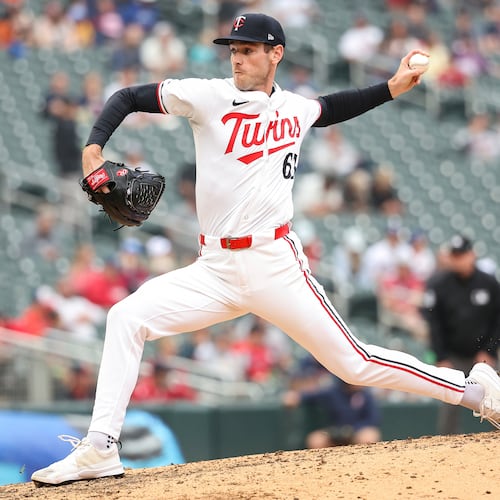Befitting their status as a contender, the Braves were buyers at the trade deadline, adding veteran players rather than shedding them this time. They added two relief pitchers, a starting pitcher and a power-hitting outfielder to the active roster in the days and hours leading to Tuesday’s non-waiver trade cutoff, without giving up any of their coveted top-tier prospects. Here’s a look at who the Braves acquired and how.
RELIEF PITCHER BRAD BRACH
The trade: The Braves acquired Brach from the Baltimore Orioles for $250,000 in international signing bonus allotment.
How the deal was done: Braves general manager Alex Anthopoulos said he and his staff "had talked about Brach on and off for a while" and saw upside even though Brach was having a subpar season. "If he wasn't having the year he was having," Anthopoulos said, "you couldn't acquire him at this rate." In addition to the bonus allotment, which was of little use to the Braves because of restrictions they face in the international market, the deal will save the Orioles the $1.75 million Brach will be paid in the next two months.
Brach's career: Brach, 32, a 6-foot-6 right-hander, is in his eighth big-league season, exclusively as a reliever. From 2013 through last season, he had a 2.79 ERA. But he declined sharply this year, posting a 4.85 ERA in 42 games with Baltimore.
Role with Braves: Brach is eligible for free agency after the season, but in the meantime he could be a significant part of their bullpen.
OUTFIELDER ADAM DUVALL
The trade: The Braves acquired Duvall from the Cincinnati Reds for pitchers Lucas Sims and Matt Wisler and outfielder Preston Tucker.
How the deal was done: Cincinnati president of baseball operations Dick Williams said Anthopoulos first expressed interest in Duvall when the Reds played in Atlanta in late June. As the trade deadline neared, the Reds decided to move Duvall to make room for younger outfielders and avoid the large raise he'll get through arbitration next year (from this season's $645,000 salary to probably $3 million-plus). The Braves gave up three players with no clear future in Atlanta. The Reds considered Sims, from Lawrenceville, the centerpiece of the deal.
Duvall's career: The right-handed-hitting outfielder slugged 33 home runs for the Reds in 2016, 31 in 2017 and 15 this season. He also was a Gold Glove finalist in left field each of the past two seasons and led MLB outfielders in assists last year. The downside is that he has a career batting average of .233, including .205 this season before the trade, and has struck out in 27 percent of his career plate appearances.
Role with Braves: The plan is for Duvall, 29, to start in left field against left-handed pitching and on other days to provide power off the bench. When Duvall starts, Ronald Acuna will move to center field and Ender Inciarte will sit. Duvall also could figure prominently in the Braves' outfield plans beyond this season because the team has contractual control through 2021.
STARTING PITCHER KEVIN GAUSMAN
The trade: The Braves acquired Gausman and relief pitcher Darren O'Day from the Orioles for four prospects – infielder Jean Carlos Encarnacion, catcher Brett Cumberland and pitchers Bruce Zimmerman and Evan Phillips – and $2.5 million in international signing allotment. O'Day won't pitch for the Braves this year because of recent hamstring surgery.
How the deal was done: It was the result of on-again, off-again talks and the most complex of the Braves' deadline deals – a match between a team in contender mode and a team in rebuild mode. The Braves wanted an experienced starting pitcher whom they could control contractually beyond this season and landed one in right-hander Gausman for four mid-tier prospects. A significant component of the deal was the Braves' willingness to take the injured O'Day's contract off the Orioles' hands; otherwise, the Braves would have had to pay a higher price in prospects for Gausman. O'Day is owed about $2.95 million for the rest of this season and $9 million next season, all of which is now the Braves' responsibility. The Orioles also save the $1.84 million Gausman will be paid for the next two months.
Gausman's career: The fourth pick of the 2012 draft, Gausman had a 39-51 record and 4.22 ERA with the Orioles. His best season was 2016, when he had a 3.61 ERA in 30 starts. He worked an average of 183 innings in 2016 and 2017. But overall he has been inconsistent, falling short of his perceived potential.
Role with Braves: Gausman, 27, joins the Braves' starting rotation and could remain there for a while. He isn't eligible for free agency until after the 2020 season.
RELIEF PITCHER JONNY VENTERS
The trade: The Braves acquired Venters from the Tampa Bay Rays for $250,000 in international signing allotment.
How the deal was done: The Braves wanted to bring back Venters, who had pitched for them in 2010-12, and the Rays wanted to unload some veterans. So they did Venters a favor five days before the trade deadline by sending him home to Atlanta and a playoff race.
Venters' career: Until this season, the left-hander had been out of the big leagues for five years because of elbow injuries. In 2010 and 2011, he pitched in 79 and 85 games, respectively, with ERAs below 2.00 each season.
Role with Braves: Although Venters, 33, admits his stuff isn't as good as it was in 2010-12, the Braves believe it is good enough to be effective, particularly against left-handed hitters.
About the Author
Keep Reading
The Latest
Featured


